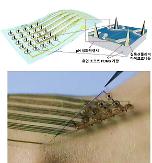
[Courtesy of KAIST]
Normally, gas sensors use integrated heaters to change the conductivity of sensor materials so that they can detect different types of metallic oxide substances included in target gases. However, such sensors consume a lot of electricity and require an external power source. The semiconductor-based sensors also have a problem of not being able to detect multiple gases at a time. A sensor could only specify a type or two types of gases at a time.
The Korea Advanced Institute of Science & Technology (KAIST) said that its researchers developed a gas sensor integrated with micro LEDs and convolutional neural network (CNN) algorithms to selectively sort and analyze five types of unknown gases with an average accuracy rate of 99.3 percent and a prediction error rate of 13.8 percent.
The newly-developed micro LED-based sensor is a photo-activated sensor with a high response rate. Different detecting materials were used to create a sensor array for the micro LED sensor and CNN was used to analyze patterns created when the target gas reacts with unique metal oxides.
"This photo-activated micro LED gas sensor consumes about 0.01 percent electricity compared to conventional sensors and we think it will become a core technique for sensor technologies for various sectors including air pollution monitoring, food decomposition monitoring, and healthcare," KAIST researcher Park In-kyu said in a statement on February 14.
Copyright ⓒ Aju Press All rights reserved.




